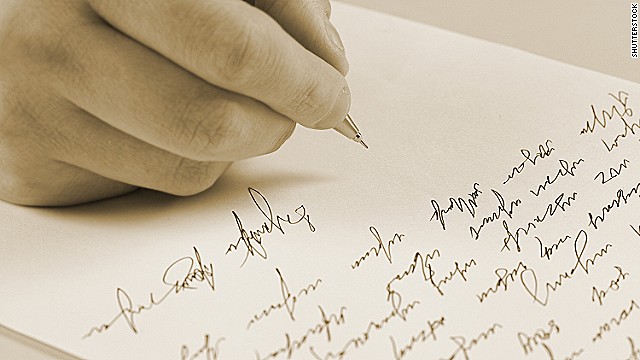Semi-ambidextrous Nicholas Cronquist rebelled against third-grade cursive lessons.
"I remember I hated it and I told my teacher I thought it was dumb," he says.
Cronquist, now 26,
eventually learned to like using his left hand to inscribe strings of
words. But typing papers while at the University of North Dakota and
choosing a career rooted in technology drastically decreased the amount
he wrote by hand, causing writing in cursive to become uncomfortable and
painful.
So he switched to printing right-handed while still signing his name with the left.
"I don't even think I know how to write in cursive anymore," says Cronquist, who now lives and works in Laos.
Technology is constantly
increasing communication speeds, often anticipating words before our
brains can send signals to our fingers. But experts say handwriting is
being sacrificed for the sake of technology's convenience. People like
Cronquist say they communicate so much via laptops, phones and tablets
that they rarely need to scribble a handwritten note.
This trend is reinforced by a 2012 study that found 33% of people had difficulty reading their own handwriting. Docmail, a UK-based printing and mailing company, conducted the study
and concluded that one in three participants had not been required to
produce something in handwriting for more than half a year. It also
found that updating calendars, phone books and reminder notes was more
likely to be completed without using a pen. Finally, more than half of
participants said their handwriting was noticeably declining.
The state of handwriting in the United States, which celebrates National Handwriting Day every January 23 -- John Hancock's birthday -- is not much better, says Wendy Carlson,
a handwriting expert and forensic document examiner. Carlson works as
an expert court witness, maintaining offices in Denver and Dallas. She
says the dramatic decline of handwriting is causing "great"
deterioration of the mind.
"Texting played a role in
it because people are trying to write quick short sentences," she says.
"People aren't using their minds and they are relying on technology to
make the decisions for them."
Carlson says cursive
writing combines mental and physical processes which involve both sides
of the brain. She says she's noticed that the number of people who write
cursive decreases as technology becomes the most dominant means of
communication.
"If you are typing or
texting, it's a matter of punching and finger-moving," she says. "You
are doing very little thinking because you are not allowing your brain
to form neural processes."
Jan Olsen is the founder and president of Handwriting Without Tears,
a company that creates handwriting curriculum guides and workbooks for
teachers and students from kindergarten through fifth grade. She says
handwriting, especially cursive, is viewed as old-fashioned by some.
"The only reason to write anything is to retrieve it later," she said. "So you need to have it legible."
Cursive requirements in
U.S. public schools have declined as access to technology increases.
Alabama, California, Georgia, Idaho, Massachusetts and North Carolina
require cursive and several other states are considering it.
The Washington Post reported
in April that 45 states have adopted common core standards for
education. Such standards are designed to provoke thought while at the
same time preparing students to pass standardized tests, but they do not
include a cursive learning requirement.
In other words, many
kids today are growing up without having to learn the looping, elegant
script that was demanded of their parents and grandparents.
Going forward, it will
be up to individual states to decide whether to require cursive and then
up to school districts to make it a focal part of the curriculum.
Burdened by budget cuts, it is likely many states and districts will
choose to have students type instead of write.
Olsen, 72, says the
writing styles used in technology and handwriting conflict. Texts and
instant messages require use of communication English, while writing
requires use of standard English, she says. "To achieve in the world,
people need to use standard (English)."
But the irony is that
Olsen, who communicates via text message on her iPhone, says Handwriting
Without Tears must be tech-savvy to remain competitive. In addition to
its workbooks, the company offers an electronic teaching guide and an
app.
"At work we have technology up the kazoo," she says.
Francis Smith, a bank
officer living in Gibraltar, says that while technology allows
instantaneous communication, he is nostalgic about handwriting due to
its permanence and tangibility.
"If there is no electricity, none of (technology) will work," he says. "Notebooks have served us for a couple thousand years."
Smith, a former civil
servant, used to write for work, but has spent the last 23 years typing
on a PC. He says it has negatively impacted his handwriting to the point
that people would never guess he won a handwriting contest when he was a
child.
"It's a shame that now when you write quickly it looks like it's by someone who has not had an education," he says.
Smith, 52, says he's started using a fountain pen to try to improve his penmanship.
"It's got a lovely feel to it," he says. "It's not very practical."
Smith says he wants to
recapture his ability to write cursive. Cronquist, however, is happy
that printing allows him to write legibly.
"My right-handed printing is not too terrible," he says. "It's slow, but readable."


No comments :
Post a Comment